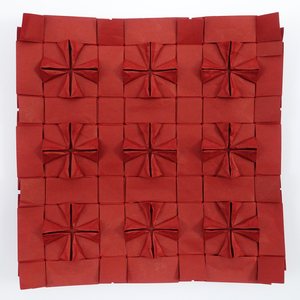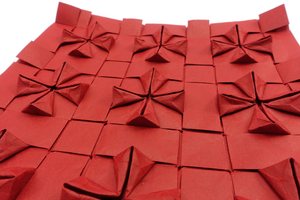Flagstone Paneling of Cross Pattee Tessellation




This origami tessellation, hand-folded from a single sheet of Biotope paper, without any cutting or glue, demonstrates my new approach to cleanly separating the individual molecules. I’ve been working on this idea for some time — being able to fold a tessellation where the areas between molecules would be flat and “at the same level” as the tessellation molecules themselves (flagstone-style). This does not always happen by itself since there are often pleats going out from the four sides of the molecule which lie above other layers and thus the areas between molecules are not of uniform thickness. One typical group are molecules with a pleat I call the “SZ pleat”, folded from an 8×8 grid to form a 4×4 molecule whose side pleat looks like the letters SZ from the side (2-1-2-1-2: two units to the right, one to the left, two to the right, one to the left, two to the right). This group includes, among others: Fujimoto’s Hydrangea, Garibi’s Red Flower and my Shamrock Tessellation (Simplified).
I derived this idea from an older design of mine, Big and Small Squares which has transitions between squares with a side of 4 units, and those with sides 2 units long. A similar gadget is used on each side of the square molecule in Flagstone Paneling. This can be thought of as a kind of level shifter. Recently, Robin Scholz has been exploring a family of designs derived from Frank Van Kollem’s ideas which he calls Versatility and which seem to be based on a similar concept as this model.
The main goal of this model is to demonstrate Flagstone Paneling in action. It works with many different molecules, and it is also possible to create variants for pleat types other than the 2-1-2-1-2 “SZ pleat”, for example for the the 1-1-4-1-1 pleat found in my Two-in-one Flower Tessellation. For this particular fold, I used my Cross Pattée Tessellation molecule which you can find for example in my older model, Coat of Arms of Rzeszów. That model nicely demonstrates what the tessellation looks like with regular pleats. The paneling also works well for boxes (pictures coming up) and gives them an elegant look without any unnecessary creases.
Together with the paneling, each molecule is 14×14 grid units, and the whole model together with margins uses a 44×44 grid.
While the most interesting part of this model is the front which shows how individual tessellation molecules can be separated from each other by areas of completely flat and uniform paper, the back side also looks quite interesting and reveals some of the twists which are used for modifying the width of pleats where the molecules transition into the paneling.
Edward Mistretta uses a similar construction in a recursive way in some of his Phantasma Fractal variants.
Comments